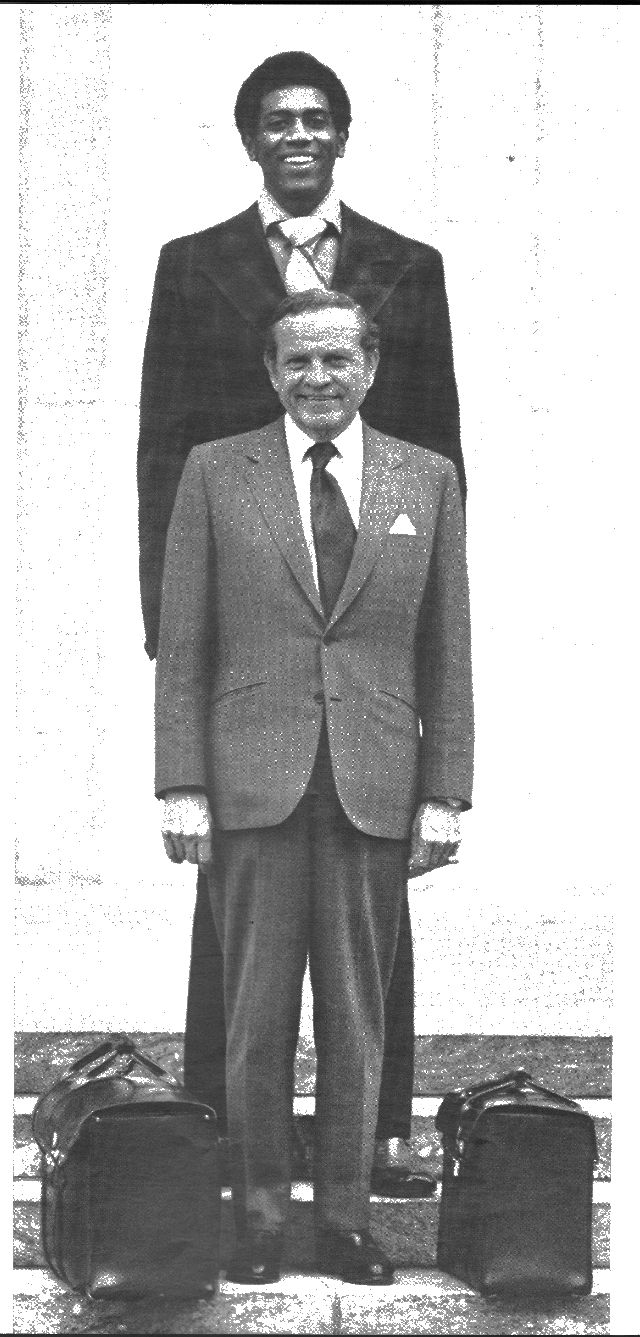
Home > General Seattle sports > Spencer Haywood Comes to Seattle
JackGordon.org
From LIFE Magazine
Page 34, April 23, 1971

photo by BILL RAY, Life Magazine
Seattle owner Sam Schulman challenged the NBA last year by signing 6' 9" Spencer Haywood in violation of a league rule which the courts later invalidated.
I didn't set out to attack the structure of sports," says Sam Schulman, the soft-spoken 61-year-old conglomerate executive and owner of the Supersonics. "But we're involved in a war. I wasn't going to stand by and watch my franchise disintegrate."
Last November, unhappy with the inability of the other NBA owners to reach agreement with the ABA, Schulman bucked the NBA power structure head-on. He tried to get Commissioner Walter Kennedy fired. "I'm continually frustrated by his weakness when he has to make decisions," Schulman says. "His deportment depends on who the owner is."
When that attempt failed, Schulman challenged the NBA's long-standing four-year rule which forbids teams signing a player until his college class has graduated. Schulman signed a tricky case, 6' 9" Spencer Haywood. In 1969, as a sophomore star at Detroit University, Haywood had quit school and signed a contract with Denver of the ABA. Last fall he jumped from Denver to Schulman's Supersonics, and Commissioner Kennedy ruled the contract invalid, citing the four-year rule. Schulman took the matter to court.
At this point, Los Angeles Laker owner Jack Kent Cooke proposed that the NBA determine "the most drastic penalties" that could be taken against Schulman—and by a 15-2 resolution the owners, in effect, threatened to throw Sam out of the league. The courts, on the other hand, said that Schulman was right, that the four-year rule was illegal, and awarded Haywood to Seattle.
"What bothers me most," Schulman said recently as he sat by the pool of his Beverly Hills home, "is that right before Cooke tried to get me thrown out of the league he asked Kennedy to put Haywood on Los Angeles' negotiating list. I'm not surprised. It's not unlike Mr. Cooke to speak out of both sides of his mouth."
The merger seems to be inevitable, but until it happens Schulman and other owners in both leagues will have to go on paying astronomical figures to untried rookies. Schulman, at least, understands the situation: "If I were an athlete I'd certainly be trying to get as much as I could. Wouldn't you?"
[Web Editor's note: Probably the loudest cheer in Seattle's Sports History -- certainly louder than anything generated by Seahawks fans -- was heard on the evening of January 14, 1971, as Coach Wilkens motioned to Haywood that he was coming in. Spencer stood up, dropped his sweats, and Seattle -- both those in attendance at the UW's Hec Ed (not the normal Seattle Center Coliseum) and the tens (hundreds?) of thousands listening to Bob Blackburn over KOMO stood and cheered ourselves hoarse. Seattle was playing the Baltimore Bullets and won the contest by a close score of 114-110. Haywood had started his career with the Supersonics 10 days earlier on January 5, playing against the same Bullets in their home court in Baltimore.]
[Web Editor's other note: Some people have wondered if the fact that David Stern was the NBA's lead attorney in Haywood v. N.B.A. (1971) had anything to do with the Sonics being ripped out of Seattle following the 2007-08 season with no apparent prospects for a return in the foreseeable future whether by expansion or moving an existing franchise.
You are at JackGordon.org,
a salute to John F "Jack" Gordon, Mr. Seattle
Copyright © 2002-2017 John R. Gordon